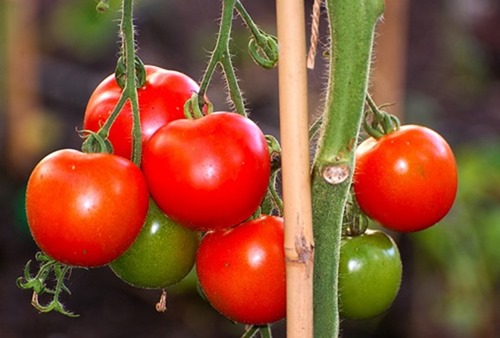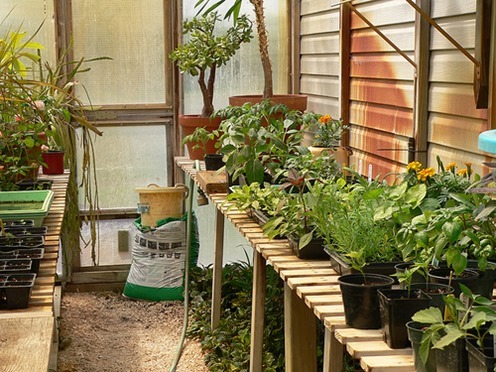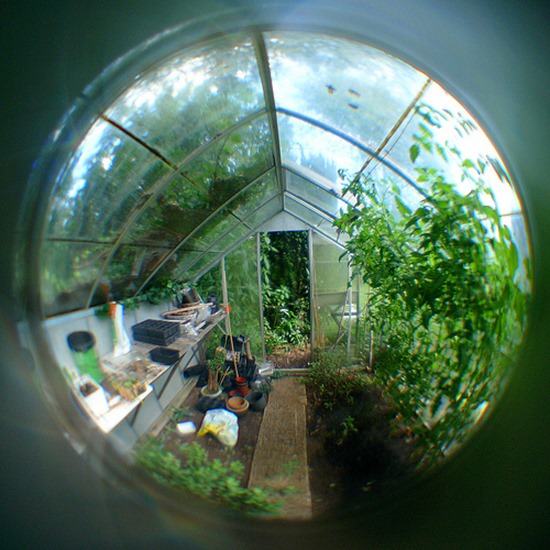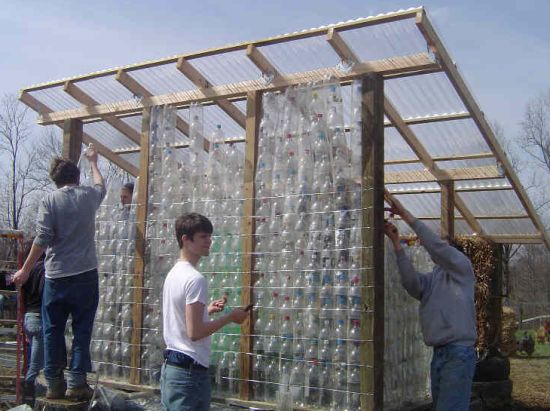Building Your Greenhouse For Success
11.3 years ago cheap, DIY, greenhouse, guest post
Most of us think of building and maintaining greenhouses as a labor of love, a fulfilling hobby, or simply an aesthetic pursuit. We invest our time, effort, and money into greenhouses for the joy of gardening and the sake of surrounding ourselves with beauty. But efficient greenhouses can also give back in more explicit ways. From filling kitchens with fresh produce to supplementing incomes and increasing property values, greenhouse success can translate into personal success in countless ways and look like a thing of beauty surrounded by exotic flowers.
Of course, the primary benefit of a greenhouse is the control it affords. A well-made greenhouse will overcome seasons, sudden temperature shifts, and blights of harmful insects. In the UK, where wintertime freezes it makes gardening impossible, with a greenhouse we can cultivate exotic species and delicate produce, while substantially extending the growing season. To optimize space, the best greenhouse plants are those with the largest flowerings and blooms relative to their size. The more dense and diverse a greenhouse, the more efficient it will be, and the fewer resources it will require to equalize temperature and humidity. Green onions, hanging patio tomatoes, peppers, and carrots are efficient growers with consistently high outputs. Narcissus and Snapdragon are large blooming flowers with relatively low space requirements
Designing Your Greenhouse
Careful planning is the key to optimizing your greenhouse’s potential. This starts with construction and continues with each new plant addition. Most greenhouses will need to be oriented North-South, to extend the growing season and maximize sun exposure. In some cases, however, due to local wind threats or special crop requirements, an East-West orientation will be more efficient, as it best utilizes light during the earliest and latest growing seasons. But no single building plan is best for everyone. The decision depends entirely upon geography and local climate.
Thoughtful planning must go into how the greenhouse is constructed, thinking about how to minimize waste and prevent costly, avoidable problems. Plan by talking with your plumbers about this so you know what access to water pipes you have, what would be needed to be built in place for water access and the cost this may involve. All this will help maintain the greenhouse in the future so is worth planning well from day one.
The next important stage is to consider how best to utilize existing resources rather than buying unnecessary implements. Is there an abandoned outbuilding on your property? Old windows lying around? Perhaps an addition to a detached garage or boathouse can help circumvent the need to build a freestanding structure. Maybe a fragment of a low-lying wall can serve as a building platform. The beauty of greenhouses is that each is unique. No single design trumps the others. Lean-to structures, triangular houses, and arched-roofs have the potential to work equally well. In regions where the weather permits, plastic sheeting and PVC can replace glass and wood. Inexpensive aluminum piping is a sturdy and easily assembled option for those in harsher climates. Ultimately, the most successful greenhouses are designed for longevity. Keep in mind that greenhouses are wet environments, so wood structures will need to be sanded, primed, and painted to avoid rot.
Many minor additions can drastically improve greenhouse productivity, stability, and sustainability. Simple rainwater and dew collection systems can lead to substantial water savings. Ventilation fans (purchased at any local hardware store) make humidity regulation easy, moisture meters and thermostats allow for scientific precision and will facilitate year-to-year refinements, a portable potting bench will prevent countless head- and back-aches, and cheap solar lighting is an eco-friendly, wireless solution. Many simple solar lights can be purchased for around £60-£100. For those who need artificial heating, the best option is electric. It is emission-free and relatively efficient. But be sure to eliminate droughts wherever possible to prevent heat loss and reduce energy costs. Also clear away or trim back nearby trees to prevent potential damage and maximize light.
Economic And Lifestyle Benefits
As the prices of organic produce continue to climb, greenhouse gardening is becoming more and more economically logical. Not only does home growing ensure your family eats the cleanest and healthiest produce, it can also be a fulfilling business venture. By selling to local farmers markets or organic co-ops, many gardeners can at least cover greenhouse expenses, and some larger greenhouses can even become quite lucrative. Growing and selling local is also an important environmental contribution: one that is more important than ever in our rapidly globalizing world economy. And with the holidays fast approaching, don’t forget that hand grown plants make wonderful gifts.
But even despite the many material benefits of gardening, at the end of the day the best aspect of a greenhouse is its function as a sanctum. Greenhouses are therapeutic places of beauty, serenity, and growth. They are a place to find balance and release stress. So take this into careful account when designing your greenhouse space. Add personal decorative touches. Consider installing a simple macadam walkway, a reading nook, wooden scrollwork, a stained-glass windowpane, or a swing seat. Plan your floral arrangements with soothing palettes in mind. It is true that successful greenhouses are a healthy economic investment. But, far more importantly, greenhouses are an investment in the health of body and mind.
—
Author: Jenny Beswick loves home improvement ideas and making her garden the focus point in her home design. Consulting with a London Plumber, careful planning and creative designs are a few steps forward to a successful greenhouse. Keep us informed on how your development plans out!
Things to know before making home garden greenhouse
11.4 years ago greenhouse, indoor growbox, indoor seed starting
There are so many options these days when you decide to own a greenhouse. You can buy a lot of greenhouse structures and modify them or just do-it-yourself. Also there are guides for you to build your own greenhouse. These guides are available on the net, and also on print.
But before you start, you first need to decide on what you need. It is also important to know or understand what you can build and what you want to grow.
Other important aspect that needs to be considered is the expenditure and the climate of your region. Space that you have at your disposal is also one of the key factors. Mentioned below are some of the things you must know before you start your dream project.
1. Location:
Always try to place your greenhouse in such a spot that enjoys a lot of sunshine. It is better that there are no shady trees around. This will have two benefits, during storms the chances of branches falling on your greenhouse is nullified, and shade from the trees will not affect the heating up of your greenhouse. More importantly shedding of the leaves from these plants can prove to be a problem to the greenhouse too.
In case the greenhouse tends to overheat, using a cover or painting it can be good options.
2. Cleaning:
If you are planning to reuse your old greenhouse or even set up your new one, make sure to clean and scrub all windows and glass parts. Also clean the outer surface. Using brown soap for cleaning seems to be the best option. In case you are cleaning the old one make sure to remove insect protections if any before the cleaning jobs starts.
3. Temperature:
The temperature in the greenhouse should range between 77 degrees F (25 degrees C) and 59 degrees F (15 degree Celsius) on the positive side. There can be lots of options to heat your greenhouse, which is very essential for the success of a greenhouse. Electrical heaters, oil or wood fuelled ones are also available with the gas powered ones; but all these heating systems particularly the last three must be ventilated to the outside properly.
These days passive solar green heating options are also available which are very much environment friendly as well. They also have a heat sink which stores the heat and uses it to heat the structure during the dark phase.
The heat needed in the greenhouse is proportional to the size of the greenhouse and also varies with the crops. Consult a professional to help you calculate the proper temperature to be maintained.
4. Ventilation:
Proper ventilation of the greenhouse is extremely important.
Ventilation will circulate air inside the greenhouse and fresh air is necessary for proper plant growth. Stale air is not conducive for proper plant growth.
5. Insulation:
Insulating the greenhouse is very important for it to function properly. The structure need to be airtight in order to bring in the best result.
6. Moisture:
The moisture inside the greenhouse needs to be maintained along with a good drainage. Overwatering and under-watering can both be harmful to the plants. So make sure to have the right amount of water, and a good drainage to ensure that its does not remain water-logged. Automated water sprinklers can be very useful. Rainwater harvesting and recycling can be environment friendly options.
7. Protection:
Protecting the plants from pests and other elements need to be one of the priorities. Make sure to use good quality soil, and treating them before use, and also use pesticides and fungicides regularly. Bio-pesticides and bio-fungicides will help for greener environment.
8. Fertilizers:
Depending on the soil quality and nutrient choose fertilizers. But do not use excessive fertilizers, as they harm the plants much more. Use bio-fertilizers like compost for best results.
Conclusion:
Take into account the climate you live in and choose the crops accordingly. That will save you a lot of pain. Non-heated greenhouse can be fine, but that will only reduce your choice of crops, and the growing season possibly. Try not to make the green house too low, or the roof flat as that may cause unforeseen trouble, as the roof might cave in at some point of time.
About The Author: Alia is a writer/blogger. She loves writing, travelling and blogging. She contributes in Morris Gad
How to make a home garden greenhouse
11.5 years ago greenhouse, guest post, winter garden
As the world is speeding up its pace of development every second, we are losing many important things on earth. Saving environment where we live is the need of the hour. We are losing so much greenery every hour around the world that the time is not far when greenery will be hard to find. Though governments are making efforts to save the environment, it’s not enough- our efforts value the most. Greenery is very important for humans life cycle as it takes in carbon dioxide and give us oxygen to breathe in.
Greenhouses are generally built to somewhat gain control over the environment suitable for plants. Greenhouses are generally build to create an atmosphere for growing off season vegetables all-round the year. One can easily make greenhouse garden at home with some easy to make a home garden greenhouse. Below are a few popular varieties you can create yourself or purchase a kit to save a considerable amount of money.
Frames
The greenhouse frames are of three types- the “Quonset” which is simple tunnel shaped, ridged beam with taller gothic shape having arched sidewalls and third one with vertical side walls having able roof. Choice of greenhouse generally depends on cost and gardening goals. The ridged beam and Quonset are mainly for rookie gardeners who have less gardening experience.
Quonset
This basic inexpensive Quonset greenhouse structure is made from 1/2 inch PVC plastic pipe. Quonset is suitable for rookie gardeners who wish to increase the growing season and are interested in cultivating early spring seedlings. Quonset base is egg shaped, two-by-four frame directly placed on the ground. The roof has several half cut plastic lengths attached to each other with the insides of longitudinal base at distance of three to five foot. It comprises of a UV-resistant heavy plastic film, which is used for covering the roof. The walls at the ends have door frames with adjustable sliding doors on both ends providing access and ventilation to greenhouse.
Gothic
Gothic greenhouses are tall as compared to Quonset shape. They have central ridge and have arched sides. Gothic greenhouses provide better headroom and storage along with the sidewalls. This type of greenhouse can be raised on ground or concrete slab if user is planning to use growing tables or raised beds. In Gothic greenhouse wooden arches are used on inside edges of the base frame on longitudinal sides. Flexible polycarbonate or see-through panels made of fiberglass are fixed to wooden frames with screws. Adjustable sliding doors are used to cover ends for ventilation and access. Gothic greenhouses can be of great use to serious gardeners who want to increase the cultivation seasons up to four times.
Rigid Frame
These greenhouses are built by professional contractors. Rigid Frame greenhouses have permanent structure without supporting pillars in center. These types of greenhouses need building permit plan approvals. Rigid Frame greenhouses are built on concrete foundations with vertical sidewalls. They have full facility of controlling humidity, lighting heating and ventilation. Its exteriors are built with fiberglass sheeting, polycarbonate panels and glass. These greenhouses can be used for cultivation all-round the year and used by professional farmers and horticultural nurseries.
These are some of the garden greenhouses which one can make according to his/her requirements and budget.
About The Author: Alia is a journalist and blogger. She is a contributor to several sites such as Marnie Bennett.
Make a greenhouse out of plastic bottles
14.9 years ago cheap, greenhouse, recycle
Not sure how long it would take to accumulate 1500 2-liter plastic bottles but if you happen to have that many piled up in your garage you have some makings for your own greenhouse.
Basic idea is you take the labels off the bottles, cut the tops off slide a pole through a hole in the bottom of the bottle, and repeat. After over a thousand iterations you have yourself a pretty cool looking greenhouse and saved most of over 1500 plastic bottles from ending up in a landfill.
This is not practical for construction for me though am considering a smaller version for a cold frame…I better start drinking up this summer.
If you want to see the full instructions check out the detailed plans.
via New World Geek











